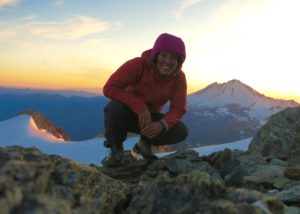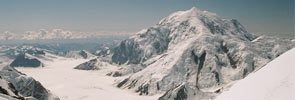Aili Farquhar
Date of Surgery: 10/13/2017
Shoulder
Update (10/2018): Aili has returned to guiding and is currently in Antarctica working with the United States Antarctic Program.
 About Aili
About Aili
I am a lifelong mountain professional. Ice and alpine climbing are my favorite disciplines, but I love rock climbing and skiing as well. My favorite ranges to climb in are the Wind River Mountains in Wyoming and the Alaska Range, as they offer remote and unique challenges in rock and ice climbing, as well as endless ski descents and long traverses. The wilder the better. I am fortunate to live in Victor, Idaho and work in Jackson, Wyoming, where prioritizing a life lived in the mountains is a normal and valued part of our community.
Career Background
I began my career in the mountains as a Park and Forest Service wilderness ranger in Olympic National Park in 2000. I worked for Bridger-Teton National Forest in Jackson, Wyoming surveying water rights before becoming a climbing ranger on Mt. Adams in southern Washington in 2004. From 2005-8 I financed my degree at The Evergreen State College by working as a deckhand on commercial salmon boats in Alaska. After college I worked as a wilderness ranger in North Cascades National Park and did a patrol on Denali before becoming a guide for Mountain Madness in 2010. I worked for Madness and the American Alpine Institute in the spring and summer and as a crab-fishing deckhand on the coast of Washington in the winter before moving back to Wyoming in 2012.
There, I began working in the oil field on the rigs as a mudlogger, then MWD Field Engineer. I returned to full-time guiding in 2015 for Exum Mountain Guides. In 2017, I began work with Alpine Ascents International. I now work a season for Alpine Ascents on Denali and the Cascades in the spring, Exum in the summer, and the US Antarctic Program in McMurdo during the fall and winter. I live in Victor, Idaho with my roommate and 19 year old cat Juniper.
Treatment Procedure and Recovery Plan
My surgery included a biceps reattachment, labrum repair, rotator cuff repair, subacromial decompression (cleanup of the bone fragments in the socket) and bone graft of the posterior socket. The graft used was from the ankle bone of a cadaver. To this individual, whoever you were, I am very grateful.
After the surgery I was on a nerve block for three days, and used a Game Ready ice machine constantly for 2 weeks, and then when my shoulder was sore for a month. My shoulder was immobilized in a sling for 6 weeks. Passive range of motion physical therapy started the day after the surgery and continued until 4 months after the surgery, at which time I was allowed to do light exercises to work on mobility. At around 2 months I could finally wash my hair with both hands!
At 2 months I began exercises to increase my range of motion in addition to passive range of motion physical therapy. I was allowed to begin cross country skiing 12 weeks after surgery. This was a huge shift as I love to get out in the snow during the winter and had only been allowed to walk up until this point. I explored all the flat and mellow cross country ski trails around Jackson Hole and Teton Valley, Idaho! I also began doing Pilates at this point, which was a good compliment to physical therapy. At four months I was allowed to start weight training on my own to start strengthening my shoulder. In early April I was finally released to ski in the backcountry (on 30 degree slopes, as I was firmly told), as well as begin to weight train.
Since then I have been able to return to a full season on Rainier, Baker and in the Alaska Range for Alpine Ascents International and in the Tetons for Exum Mountain Guides. I am so happy to be back in the mountains doing the work I love!
Testimonial

"I lay in the MRI machine in 2015 as it echoed and thumped and clicked, and I cried. I cried because I was a little claustrophobic, but even more afraid of what the images would tell the orthopedic surgeon I was working with. I knew something had been very wrong with my shoulder since a mountain bike crash at age 19 and a lifting injury in Crossfit in 2014. I had toughed out the pain through the years of climbing and lucrative labor jobs it took to become a professional mountain guide on track towards my AMGA certification, but the pain had become so great that after a big day guiding or climbing my shoulder would keep me awake at night. The results confounded my orthopedic surgeon, and he referred me to someone else within his orthopedic medicine practice. This doctor said the damage to my shoulder was too extensive to fix, and referred me to a third orthopedic surgeon in another state. This doctor recommended a full shoulder replacement and said he would forbid me from overhead lifting for the rest of my life. I’m a climber. I’m a mountain guide. This would mean the end of my career and the way I most passionately connect with the natural world. I went to the Steadman Clinic in the fall of 2016 as a last resort. I was not willing to accept that I would either live with pain or be done with my career as a climbing guide at the age of 35, and was willing to do anything within my ability to find someone who could fix my shoulder and save my career. Dr. Tom Hackett at the Steadman Clinic told me that while rare in someone so young, my injury was repairable. The procedure he would use was rare and was not guaranteed to work. As I listened to him describe the recommended surgery and timeline for recovery – at least six months, as a bone graft was required to rebuild the part of the socket that had been shattered in the mountain bike crash – hope again rose in my chest. I had no idea how I was going to take six months from financially lucrative work in addition to paying what Marketplace insurance would not cover. I was determined to find a way. On the way out of the office, already ecstatic at the prospect of pain-free climbing, one of the nurses told me about the Kees Brenninkmeyer Foundation and handed me a sheet of information. When I began to correspond with them and ask my guiding colleagues about their experiences receiving support from them I was blown away. The support I have received has exceeded any expectations I had and allowed me to focus all my energies on my recovery instead of worrying about incurring debt. The surgery – which ended up being 5 different procedures at the same time, including a cadaver bone graft to repair my posterior shoulder socket – was much rougher than I expected. The support from the Kees Brenninkmeyer Foundation with travel and hotel expenses next to the hospital was essential to my ability to get to physical therapy at the amazing Howard Head physical therapy center and follow up appointments while I was still on a nerve block, Game Ready ice machine and heavy medication. Their support with physical therapy expenses allowed me to see a provider in my home community of Jackson, Wyoming that understood the requirements of the profession and sport I was working to return to. This procedure and the support of the Kees Brenninkmeyer Foundation has changed my life and allowed me to continue my profession and passion by seeking out the best surgical and rehabilitative care I could find. "
- Aili Farquhar

